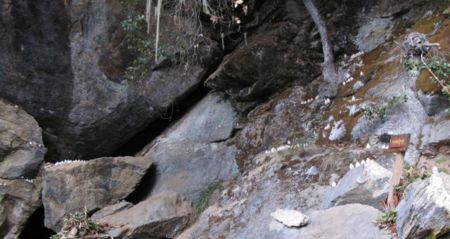Padampa Sangye: Difference between revisions
Jump to navigation
Jump to search
No edit summary |
mNo edit summary |
||
| Line 2: | Line 2: | ||
'''Padampa Sangye''' ([[Wyl.]] ''pha dam pa sangs rgyas''; Skt. ''Paramabuddha'') (d.1117) — the great Indian [[siddha]] visited Tibet and Bhutan several times. His main disciple was [[Machik Labdrön]] (1055-1149) who founded the lineage of [[Chö]] in Tibet and Bhutan. | '''Padampa Sangye''' ([[Wyl.]] ''pha dam pa sangs rgyas''; Skt. ''Paramabuddha'') (d.1117) — the great Indian [[siddha]] visited Tibet and Bhutan several times. His main disciple was [[Machik Labdrön]] (1055-1149) who founded the lineage of [[Chö]] in Tibet and Bhutan. | ||
Both he and [[Machik Labdrön]] meditated in caves near [[Taktsang Monastery]] in Bhutan. | |||
==Further Reading== | ==Further Reading== | ||
Revision as of 20:17, 13 October 2009

Padampa Sangye (Wyl. pha dam pa sangs rgyas; Skt. Paramabuddha) (d.1117) — the great Indian siddha visited Tibet and Bhutan several times. His main disciple was Machik Labdrön (1055-1149) who founded the lineage of Chö in Tibet and Bhutan.
Both he and Machik Labdrön meditated in caves near Taktsang Monastery in Bhutan.
Further Reading
- Padampa Sangye and Chökyi Senge, Lion of Siddhas: The Life and Teachings of Padampa Sangye, translated by David Molk with Lama Tsering Wangdu Rinpoche, Snow Lion Publications, 2008.
- Dilgo Khyentse Rinpoche & Padampa Sangye, The Hundred Verses of Advice—Tibetan Buddhist Teachings on What Matters Most, Shambhala, 2006.